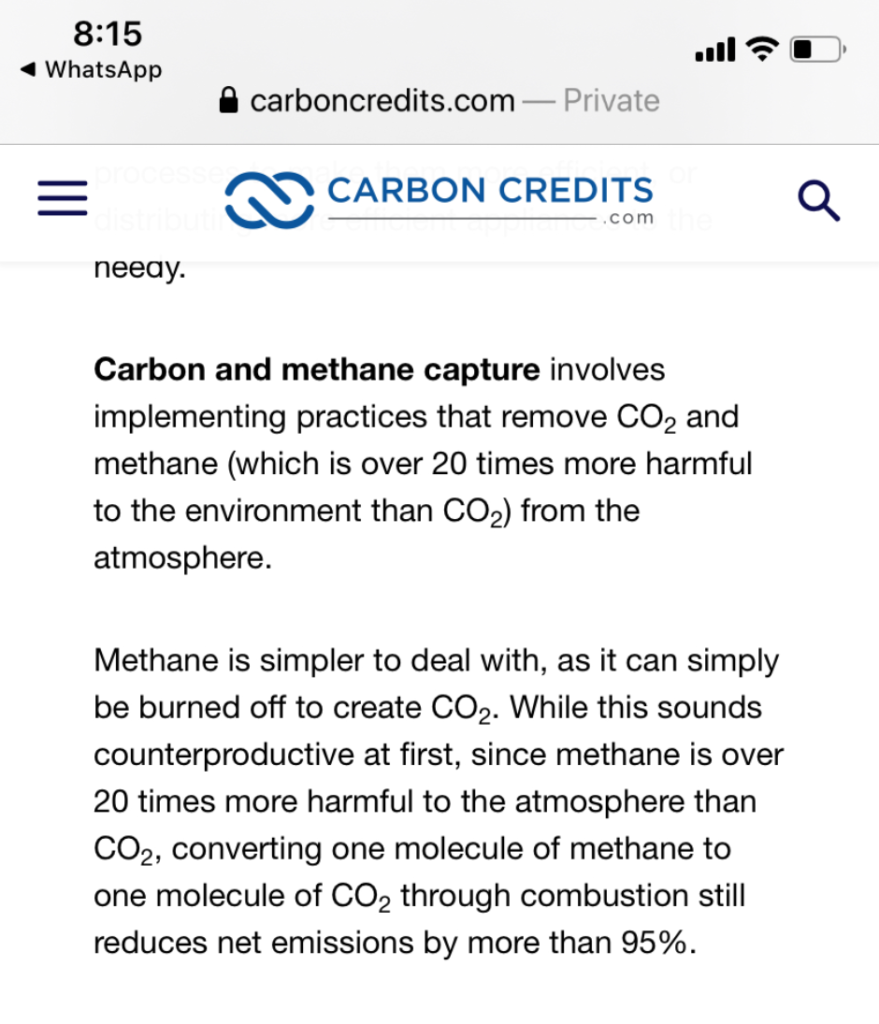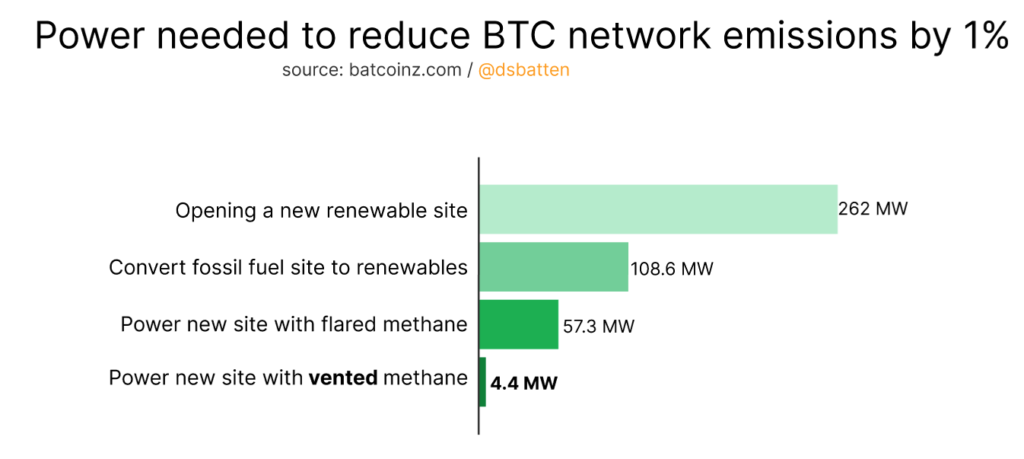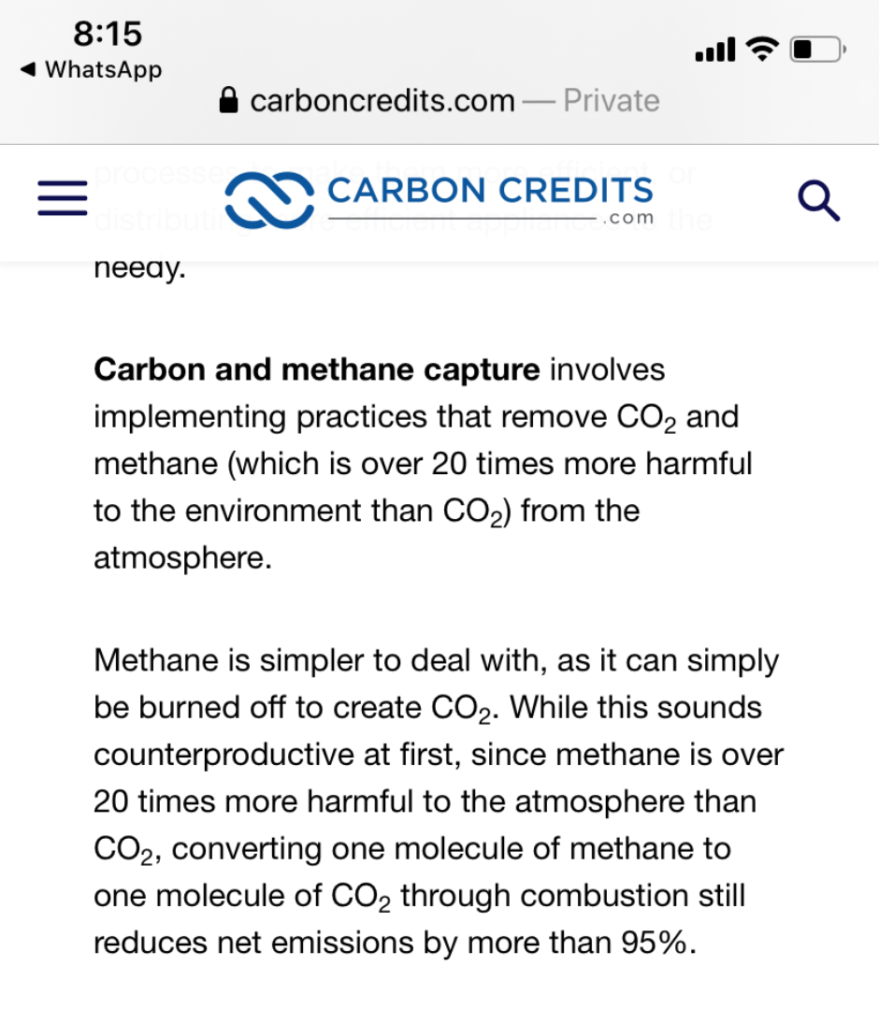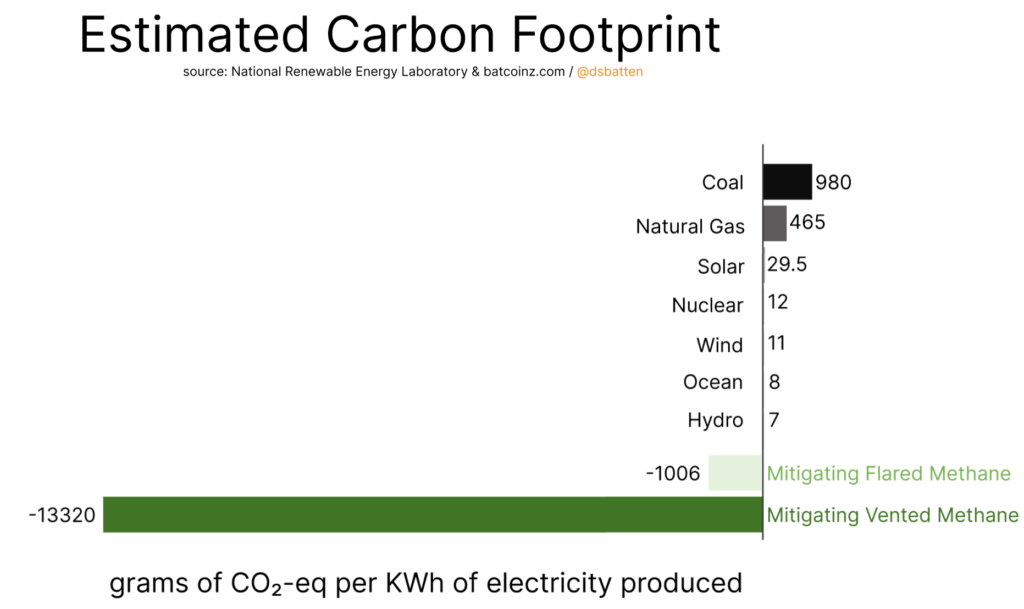
Executive Summary: By an order of magnitude, using vented methane as a power source is the most carbon negative fuel source. Of different vented sources, landfills are the most economically viable source. Wastewater methane can be repurposed to run power-hungry waste-water treatment plants, but landfills are isolated and generally the grid infrastructure is inadequate to allow sale of power back to the grid.
For this reason, the customer (offtaker) for that landfill gas power must be able to colocate at the landfill itself.
While burning natural gas is emission positive, somewhat counterintuitively when you burn methane that would have been vented into the atmosphere that is a form of “carbon and methane capture”. Why? Because that methane is so much more harmful than carbon dioxide.

This article quantifies how emission-negative each is, and also looks at how emission-negative combusting Landfill Gas is (which is sometimes vented, sometimes flared)
Summary of Findings

There are 3 forms of power-usage are CO2-eq (carbon dioxide equivalent) emission negative: flared methane, vented methane, and sometimes flared/sometimes vented methane. In all cases combusting methane is only carbon negative when it would have otherwise been released into the atmosphere. When it would have otherwise stayed in the ground it is carbon positive, and is not the subject of this study. The study finds that:
- Combusting previously flared methane reduces CO2-eq emissions by 63%. For every KWh of electricity produced, it mitigates a net 1006g of CO2-eq that would have gone into the atmosphere.
- Combusting previously vented gas (biogas from farms and wastewater, targeting only vented landfills, orphaned oil wells) reduces CO2-eq emissions by 95%. For every KWh of electricity produced, it mitigates a net 13320g of CO2-eq that would have gone into the atmosphere.
- Combusting methane that was 30% flared/70% vented (ie: the general cross-section of US Landfills) reduces CO2-eq emissions by 88%
CALCULATIONS
Carbon reduction through combusting methane that would have been flared
Examples include using previously flared natural gas from operational oilfields

When methane is used to generate power, rather than flared, you get less methane and more CO2.
So what’s the difference that makes?
First we calculate how much carbon would have been released had we burnt that in a flare stack
We know that flare stacks are 92% efficient. In other words, they burn 92% of the methane, and release 8% of the methane into the air.
Both methane (CH4) and carbon dioxide (CO2) contain carbon, however methane is 84x times more warming than CO2. So it’s really bad. That’s why, if possible you don’t want either CO2 or CH4 emitting into the air. If you can’t disappear them both, having carbon dioxide rather than methane go into the air is an order of magnitude less harmful option.
So in a flare stack there are 2 sources of carbon emission
- The carbon dioxide created by burning 92% of the methane
- The 8% unburnt methane
Scientists use a term called “Carbon dioxide equivalent” (also called CO2-e or sometimes CO2-eq). This is a way of catering for the fact that methane is 84x more warming than CO2 over a 20 year period.
So we can say that 1 t methane = 84 t CO2-eq (1 Tonne of methane has an equivalent impact to global warming over a 20 year period as 84 t CO2).
Scientists call this the Global Warming Potential (GWP). So methane has a 20-year GWP of 84, whereas CO2 has a GWP of 1.
The final thing for us to factor in is that when methane burns, it produces not 1 t but 2.75x t CO2.
A. CO2-eq created by flaring
So the total CO2-eq of flaring is
- 0.92 x 2.75t = 2.53 t CO2-eq +
- 0.08×84 = 6.72 t CO2-eq
So the total CO2-eq created by flaring is 9.25 t CO2-eq
B. CO2-eq created by combustion
Modern generators can now achieve up to 99.89% elimination of methane. So there will be slightly more CO2 emitted, but a lot less methane emitted.
So the total CO2-eq of combustion is
- 0.9989×2.75t = 2.747 t CO2-eq +
- 0.0011×84 = 0.092 t CO2-eq
So the total CO2-eq created by combustion is 2.839 t CO2-eq
C. So this represents a reduction in carbon (CO2-eq) of (1-2.839/9.25)= 69.3%.
But why does Crusoe Energy say that their generation only reduces carbon emissions by 63%? Well that’s because we still need to factor in one more thing: natural gas is not 100% methane. It’s only around 80-95% methane, and the remaining other particles include larger hydrocarbon molecules which still create CO2, but don’t have the same ultra-high GWP as methane when left unburnt. I omitted that in the initial model for simplicity. When we factor that in, we get a slightly lower carbon reduction, because there wasn’t as much methane in the first place. Let’s be conservative and take the lower 80% figure.
So the slightly more complex equation model looks like this :
Carbon reduction % = (1-B/A)
B = CO2-eq that would have been produced without methane capture and combustion
A = CO2-eq that is produced through methane capture and combustion.
When 1 t of previously flared methane is captured for combustion:
A = (0.92 x 2.75t) + (0.08×0.8×84) = 2.53 t CO2-eq + 5.376 t CO2-eq
= 7.906 t CO2-eq
And B = (0.9989×2.75t) + (0.0011×0.8×84) = 2.747 t + 0.0736 t
= 2.821 t CO2-eq
- Carbon reduction = (1- 2.821/7.906) = 64%.
This is still slightly higher than Crusoe’s 63% which uses a more sophisticated model taking into account the higher mass of CO2 produced when larger hydrocarbons such as propane and butane, which are present when natural gas combusts. (This explains why the simpler model here will be marginally overstating the carbon reduction).
Summary of carbon reductions when previously flared natural gas is captured and combusted
1. Carbon reduction = 63%.
2. Net carbon saving is -1.7 t per tonne.
(For every 2.821 t of CO2-eq produced, 7.906 t was mitigated. So Carbon Footprint per tonne of CO2-eq = (2.821-7.906/2.821) = -1.8 (-1.7 taking into consideration combustion of higher hydrocarbons). To think of it another way, for every tonne of CO2-eq produced, 2.7 tonnes of CO2-eq were mitigated from going into the atmosphere, so the net saving is -1.7 t per tonne).
3. Carbon footprint per KWh = -1006g (1 t methane produces 4.79 MWh, which mitigates (2.821 – 7.906) = -5.085 t CO2-eq => 1 KWh has a carbon footprint of -5.085 kg/ 4.79= -1.06 kg or -1006 g)
Still significant !
- Another way to think of this is that for every tonne CO2-eq that is emitted, (1/(1-0.63)) = 2.703 t CO2-eq that would have gone into the atmosphere is eliminated: a net benefit of -1.703 Tonnes per Tonne.
If that’s significant, the carbon reduction possible when that gas would have been vented is even more significant
2. Carbon reduction through combusting methane that would have been vented

This is what happens when power is generated using natural gas from orphaned oilwells that was previously venting directly into the atmosphere, or for the methane component of vented landfill gas or vented biogas from farms or wastewater.
Here using the equation from above: Carbon Reduction = (1-B/A), B will be the same, but A will be larger, because all of the methane is released: a full 84 t of CO2-eq.
Carbon reduction = 1-( 2.821/84) = a 96.6% reduction! (of the methane component of the gas)
So when for example a vented orphaned oil well is combusted and we factor in that only 80% of that natural gas was methane, the net reduction will be
1-(2.821/67.2) = 95.8% carbon reduction.
However, outside the Oil & Gas industry, a recently upheld patent on Crusoe’s generation technology suggests that access to generators with 99.89% methane elimination capacity may not be possible. So we assume a lower 99% methane elimination, which reduces the overall carbon reduction from 95.8% to 1-([(0.99×2.75t) + (0.01×0.8×84)/84]) = (1-3.3945/67.2) = 94.95%
Summary of carbon reductions when previously vented natural gas is captured and combusted
1. Carbon reduction = 94.95%.
2. Net carbon saving is -18.79 t per tonne.
(For every 3.3945 t of CO2-eq produced, 67.2 t was mitigated. So Carbon Footprint per tonne of CO2-eq = (3.3945-67.2/3.3945) = -18.79. To think of it another way, for every tonne of CO2-eq produced, 19.79 tonnes of CO2-eq were mitigated from going into the atmosphere, so the net saving is -18.79 t per tonne).
3. Carbon footprint per KWh = -13320 g (1 t methane produces 4.79 MWh, which mitigates (3.3945-67.2) = -63.8055 t CO2-eq => 1 KWh has a carbon footprint of -63.8055 kg/ 4.79= -13.32 kg or -13320 g)
3. Carbon reduction through combusting methane from general Landfill Gas

In the US, 30% of Landfill Gas (LFG) is flared, 70% is vented (source: EPA/ Vespene pitch deck).
The methane content from LFG is variable. For this reason, when talking about methane mitigation in the Municipal Landfills, we refer to the methane component of LFG.
The net emission reduction through combusting the methane component of LFG is 0.3×0.693 + 0.7×0.966 = 0.2079+0.6762 =
88.4% reduction of CO2-eq emissions.
4. Additional power required to make the Bitcoin Network more carbon-neutral
Currently the Bitcoin network generates 27.02 M t CO2-eq emissions and is 41.5% fossil-fuel based on a current power consumption of 10.86 GW (This figure is dynamically calculated and accurate at time of writing: 12th Sept ’22) => a 27.02/41.5 = 0.65 M t CO2-eq reduction will reduce the carbon-intensity of the Bitcoin network by 1%.
To fully offset the Bitcoin network’s carbon emissions requires 183.6 MW power from vented methane; 2254 MW using flared methane.

4.1 Using vented methane
- Reducing 1 M t emissions would require 183.6/27.02 = 6.8 MW
- Reducing 1% of the Bitcoin network’s emissions would require 6.8×0.65 = 4.43 MW
4.2 Using flared methane
- 1 M t emissions would require 2254/27.02 = 83.4 MW
- Reducing 1% of the Bitcoin network’s emissions would require 83.4×0.65 = 57.3 MW
4.3 Converting a fossil fuel plant to renewable energy
For example Marathon migrating from it’s coal-powered operation in Hardin, Wyoming to it’s new wind farm in Garden City, Texas), it would require 1% of 10.86 GW = 108.6 MW =>
- 1 M t emissions would require 108.6/0.65 = 167.1 MW
- Reducing 1% of the Bitcoin network’s emissions would require 108.6 MW
4.4 A new 100% renewable-based operation
This would take a lot more power, as only 41.5% of the network is still fossil-fuel based => it would need 108.6/0.415 = 262 MW =>
- 1 M t emissions would require 262/0.65 = 403.1.1 MW
- Reducing 1% of the Bitcoin network’s emissions would require 262 MW
Final note
Is combustion of atmosphere-bound methane recognized as being carbon capture/ carbon negative? The answer is yes, this has been recognised as carbon negative well before bitcoin mining operations started using atmosphere-bound methane in this way. Carboncredits.com for example states:

Document Revisions:
12 Sept 2022: Added sub-section 4 to Calculations section
12 Dec 2022: Replaced leading graph with an “apples for apples” comparison that measures non-Life Cycle emissions with non-Life Cycle emissions (impact: solar and other renewables become zero, as they release zero emissions as a direct result of the generation process). Previous version of the graph as below.

28 May 2023: Added Executive Summary
